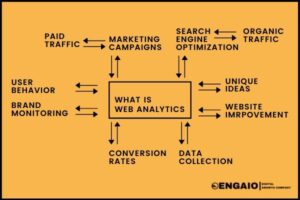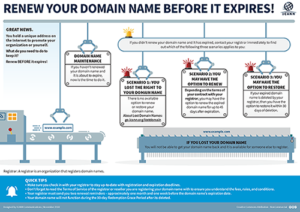Curious about web analytics in digital marketing? Well, buckle up because I’m about to take you on a thrilling ride through the world of data and insights. Web analytics is like the secret weapon of digital marketers, allowing them to unravel the mysteries behind website performance and user behavior. It’s like a detective’s magnifying glass, helping marketers make informed decisions and optimize their strategies. So, let’s dive in and uncover the fascinating realm of web analytics!
Imagine you’re a digital marketer. You’ve got your website up and running, you’re churning out content, and you’re engaging with your audience on social media. But how do you know if all your efforts are paying off? That’s where web analytics comes in. It’s like having a crystal ball that reveals valuable insights about your website’s performance, user behavior, and the effectiveness of your marketing campaigns. With web analytics, you can track metrics like website traffic, conversion rates, bounce rates, and even the paths users take on your site. Armed with this knowledge, you can tweak your strategies, optimize your website, and ultimately drive more success in the digital landscape.
But wait, there’s more! Web analytics isn’t just about numbers and graphs. It’s about understanding your audience on a deeper level. It’s about uncovering their preferences, their needs, and their pain points. By analyzing the data, you can gain valuable insights into who your audience is, what they’re looking for, and how you can better serve them. It’s like having a direct line to their thoughts and desires. So, whether you’re a seasoned marketer or just dipping your toes into the digital marketing world, web analytics is a must-have tool in your arsenal. Get ready to unlock the secrets of your website and take your digital marketing game to a whole new level!

Understanding Web Analytics in Digital Marketing
Web analytics is a crucial aspect of digital marketing that allows businesses to measure, analyze, and interpret data related to their website. It provides valuable insights into the performance of a website, helping businesses make informed decisions to improve their online presence and drive better results. By tracking and analyzing various metrics, web analytics helps businesses understand their audience, measure the effectiveness of their marketing efforts, and identify areas for improvement.
The Importance of Web Analytics
Web analytics plays a significant role in digital marketing by providing actionable data that can be used to optimize strategies and drive better outcomes. Here are a few reasons why web analytics is crucial:
- Understanding User Behavior: Web analytics allows businesses to gain insights into how users interact with their website. It provides information on user demographics, the pages they visit, the actions they take, and the devices they use. This data helps businesses understand their target audience better and tailor their marketing strategies to meet their needs.
- Measuring Marketing Campaigns: By tracking key performance indicators (KPIs) such as traffic, conversions, and engagement, web analytics helps businesses evaluate the success of their marketing campaigns. It enables them to identify which channels and tactics are driving the most valuable results, allowing them to allocate their resources effectively.
- Identifying Conversion Bottlenecks: Web analytics provides insights into the conversion funnel, helping businesses identify any obstacles or bottlenecks that may be hindering conversions. By analyzing user behavior and identifying areas of drop-off, businesses can optimize their website and marketing strategies to improve conversion rates.
- Optimizing User Experience: With web analytics, businesses can gain insights into how users navigate their website, which pages are most popular, and where users may be experiencing difficulties. By understanding user behavior, businesses can make data-driven decisions to improve the user experience and maximize engagement.
The Key Metrics in Web Analytics
Web analytics involves tracking and analyzing various metrics to gain insights into website performance. Here are some key metrics that businesses should focus on:
1. Traffic Sources
Understanding where your website traffic comes from is essential for evaluating the effectiveness of your marketing efforts. Web analytics can provide insights into the different sources of traffic, such as organic search, paid search, social media, referrals, and direct traffic. By analyzing traffic sources, businesses can determine which channels are driving the most valuable visitors to their website.
2. Bounce Rate
The bounce rate measures the percentage of visitors who leave a website after viewing only one page. A high bounce rate may indicate that users are not finding the content they expected or that the website’s user experience needs improvement. By monitoring and analyzing the bounce rate, businesses can identify areas for optimization and enhance user engagement.
3. Conversion Rate
The conversion rate measures the percentage of website visitors who complete a desired action, such as making a purchase, filling out a form, or signing up for a newsletter. It is a critical metric that indicates the effectiveness of a website in driving desired outcomes. By tracking and optimizing the conversion rate, businesses can increase their chances of achieving their goals.
4. Average Session Duration
The average session duration measures the amount of time users spend on a website. It provides insights into user engagement and the quality of the website’s content. A longer average session duration indicates that users are finding value in the website and spending more time exploring its pages. By analyzing this metric, businesses can identify content that resonates with their audience and optimize their website accordingly.
Using Web Analytics Tools
There are various web analytics tools available that can help businesses collect and analyze data about their website’s performance. Some popular tools include Google Analytics, Adobe Analytics, and Matomo. These tools provide comprehensive insights into website traffic, user behavior, conversions, and other important metrics. By leveraging these tools, businesses can make data-driven decisions and optimize their digital marketing strategies for better results.
Conclusion
Web analytics is a powerful tool that allows businesses to gain valuable insights into their website’s performance. By tracking and analyzing key metrics, businesses can make informed decisions and optimize their digital marketing strategies to drive better results. Whether it’s understanding user behavior, measuring marketing campaigns, identifying conversion bottlenecks, or optimizing user experience, web analytics plays a crucial role in helping businesses succeed in the digital landscape.
Key Takeaways: What is Web Analytics in Digital Marketing?
- Web analytics is the process of collecting and analyzing data from websites to understand user behavior and improve marketing strategies.
- It helps businesses track website traffic, user demographics, and engagement metrics to make data-driven decisions.
- Web analytics tools like Google Analytics provide valuable insights into website performance, such as page views, bounce rates, and conversion rates.
- By analyzing web data, marketers can optimize their websites, target specific audiences, and measure the effectiveness of marketing campaigns.
- Web analytics is essential in digital marketing as it enables businesses to generate more leads, increase conversions, and improve overall marketing ROI.
Frequently Asked Questions
What is the importance of web analytics in digital marketing?
Web analytics plays a crucial role in digital marketing by providing valuable insights into the performance of a website. It helps businesses understand user behavior, track website traffic, measure the effectiveness of marketing campaigns, and identify areas for improvement. By analyzing data such as page views, bounce rates, conversion rates, and user demographics, web analytics enables marketers to make data-driven decisions and optimize their digital marketing strategies.
With web analytics, businesses can monitor the success of their online marketing efforts, identify the sources of traffic, and determine which marketing channels are driving the most conversions. This information is essential for improving ROI, identifying target audiences, and tailoring marketing messages to maximize engagement and conversions.
What are the key metrics used in web analytics?
Web analytics involves tracking and analyzing various metrics to measure the performance of a website. Some of the key metrics used in web analytics include:
1. Traffic sources: This metric helps identify where the website traffic is coming from, such as search engines, social media platforms, or referral websites.
2. Page views: Page views indicate the number of times a particular page on the website has been viewed by users.
3. Bounce rate: Bounce rate measures the percentage of users who leave the website after viewing only one page. A high bounce rate may indicate a need for website improvements.
4. Conversion rate: Conversion rate measures the percentage of website visitors who complete a desired action, such as making a purchase or filling out a form.
These metrics, along with many others, provide valuable insights into user behavior, website performance, and the effectiveness of marketing campaigns.
How is web analytics data collected?
Web analytics data is collected through various methods, including:
1. Tracking codes: Websites are equipped with tracking codes, such as Google Analytics, that collect data on user interactions, page views, and other metrics. These codes are embedded in the website’s HTML code.
2. Cookies: Cookies are small text files that are stored on a user’s device when they visit a website. They collect data on user behavior and preferences, which can be used for web analytics purposes.
3. Log files: Web servers generate log files that record information about user requests, server responses, and other relevant data. These log files can be analyzed to extract web analytics insights.
By utilizing these methods, web analytics tools gather data that is then processed and analyzed to provide meaningful insights for digital marketers.
How can web analytics help in improving website performance?
Web analytics can provide valuable insights to improve website performance in several ways:
1. User experience optimization: By analyzing user behavior, web analytics can identify areas of the website that may be causing frustration or confusion for users. This information can be used to make improvements and enhance the overall user experience.
2. Content optimization: Web analytics can help identify which types of content are resonating with users and driving engagement. By analyzing metrics such as time on page and bounce rate, marketers can optimize their content strategy to deliver more relevant and engaging content.
3. Conversion rate optimization: By tracking conversion rates and analyzing user behavior, web analytics can help identify barriers to conversion and optimize the conversion funnel. This can lead to higher conversion rates and improved ROI.
Overall, web analytics provides actionable insights that can help businesses make data-driven decisions to enhance website performance and achieve their digital marketing goals.
What are the popular web analytics tools available?
There are several popular web analytics tools available that can help businesses track and analyze website data. Some of the most widely used tools include:
1. Google Analytics: Google Analytics is a free web analytics tool provided by Google. It offers a comprehensive range of features to track website traffic, user behavior, conversion rates, and much more.
2. Adobe Analytics: Adobe Analytics is a robust web analytics platform that provides advanced analytics capabilities and real-time data insights. It offers a wide range of features for tracking and analyzing website performance.
3. Kissmetrics: Kissmetrics is a web analytics tool that focuses on customer behavior analytics. It provides insights into customer journeys, conversion rates, and customer segmentation.
4. Mixpanel: Mixpanel is a web analytics platform that specializes in event-based analytics. It allows businesses to track user interactions and analyze the effectiveness of specific events or actions on their websites.
These are just a few examples of the many web analytics tools available. The choice of tool depends on the specific needs and requirements of the business.
What is web analytics?
Final Summary: Understanding the Power of Web Analytics in Digital Marketing
Web analytics is a game-changer in the world of digital marketing. It provides invaluable insights into the performance of your online presence, allowing you to make data-driven decisions and optimize your strategies for success. By utilizing the power of web analytics, you can unlock a treasure trove of information that will help you understand your audience, track the effectiveness of your marketing efforts, and ultimately achieve your business goals.
Through web analytics, you gain a deeper understanding of your website visitors, their behavior, and their preferences. It allows you to track key metrics such as traffic sources, page views, bounce rates, and conversion rates. Armed with this knowledge, you can tailor your marketing campaigns to target the right audience, optimize your website for better user experience, and create content that resonates with your visitors.
Not only does web analytics provide insights into your current performance, but it also enables you to track the effectiveness of your marketing campaigns in real-time. By monitoring metrics like click-through rates, conversion rates, and engagement rates, you can identify which strategies are working and which ones need adjustments. This data-driven approach ensures that you are allocating your resources wisely and maximizing your return on investment.
In conclusion, web analytics is a powerful tool that can revolutionize your digital marketing efforts. It empowers you to make informed decisions, optimize your strategies, and achieve better results. By leveraging the insights provided by web analytics, you can stay ahead of the competition, connect with your target audience, and drive meaningful business growth. So, embrace the power of web analytics and unlock the full potential of your digital marketing endeavors.







